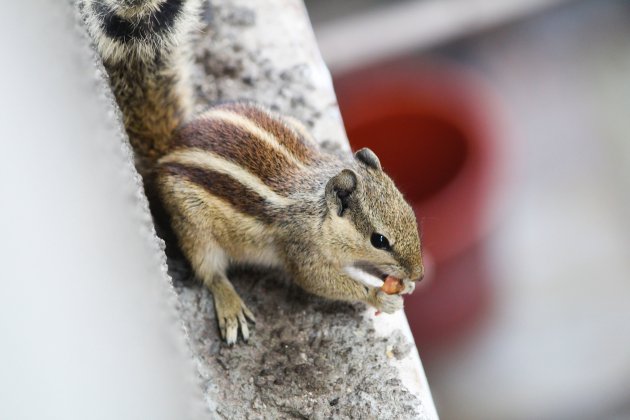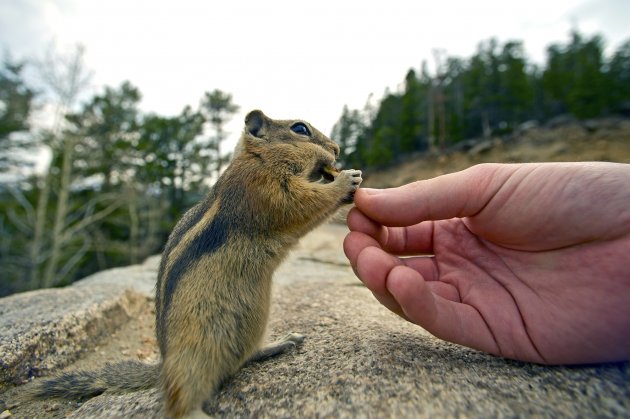The chipmunk is a small rodent found mainly in North America with 25 species to its name. Although when we hear the name 'chipmunk' we probably mostly think of the small animal with "racing stripes" down its back, mooching peanuts from us at the local campground or park. However, these little critters are now being domesticated and put into the pet trade.
If you think keeping a chipmunk as a pet may be right for you, here are some things you will want to know before you bring one home.

The Chipmunk’s Appearance
Adult chipmunks will measure from 8 to 11 inches, including their tail. Their colors range in the greys, browns, and reddish-browns with numerous strips down their back and on their cheeks.
This cute rodent has cheek pouches where they stuff their food to transport it back to their dens. The ears are small and upright, and they have black eyes and whiskers on their pointed snouts.
Each foot has tiny-clawed toes designed to help these rodents dig and climb.
Chipmunk’s Behavior
A part of the appeal of the chipmunk (aside from its adorable appearance) may be its lively and quick personality. In the wild, this rodent emits a bird-like chirp to warn others of approaching danger. It is diurnal, meaning it is most active during the daytime hours. Chipmunks also hibernate during the colder months starting in late autumn to early the next spring.
The chipmunk as a pet will take time to socialize as it is by nature, a skittish and timid animal. This rodent can also scare easily and may bite if it feels threatened, therefore it is not recommended for children. However, the species does like to play and enjoys the company of other chipmunks.

Housing a Chipmunk
Since the chipmunk is a busy rodent, you should provide your pet with as much room as possible. With this in mind, a standard hamster or gerbil cage is not appropriate for a pet chipmunk. The cage for this animal should measure a minimum of 4 feet by 3 feet by 4 feet with plenty of branches to climb on, foliage to hide in, pipes, rocks, and shelves to provide mental and physical stimulation. The enclosure should have two or three solid sides with a strong mesh front.
Since the chipmunk is a burrowing animal, you will need substrate in peat, paper, or sawdust. You will also need to provide your chipmunk with a nest box, measuring about 20 cm by 20 cm (if you have more than one adult, you will need to provide a nesting box for each).
Tips on Keeping a Pet Chipmunk
For a happy and healthy chipmunk, keep these simple tips in mind.
Tip #1 - Chipmunks will tend to use one corner as a bathroom, clean this area daily, and replace the substrate. Clean the entire cage weekly.
Tip #2 - Provide your chipmunk with hay or shredded paper in the nesting box.
Tip #3 - Do not house adult males together as they will fight.
Tip #4 - Only clean the nesting box twice a year. Leave the nesting box untouched from September to March as it will store food in preparation for hibernation.
Tip #5 - Special heating is not needed, but be sure the enclosure is well ventilated and mouse-proof to avoid infection of your pet chipmunk.

Feeding a Chipmunk
Chipmunks are natural foragers and eat a wide variety of food. To keep your pet chipmunk healthy, the following foods will serve as an appropriate diet.
- Prepackaged hamster food
- Small bits of cooked meat or egg
- Dry dog or cat food
- Berries
- Nuts
- Seeds
- Wholemeal pasta (raw)
- Green leafy veggies (in small quantities)
Vary your pet chipmunks diet to ensure you are meeting all of its nutritional needs. You will also want to provide your chipmunk with clean water in a gravity-bottle attached to the cage.
Handling Your Chipmunk
Chipmunks have not been in the pet world for very long, so they are still considered “semi-wild.” If purchased at a young age, your chipmunk can respond to its name and become accustomed to gentle handling. NEVER try to take a chipmunk from the wild and tame it. Wild chipmunks DO NOT make good pets. In fact, in some regions, this rodent is not legal to keep as a pet.
When socializing your pet chipmunk, move slowly and do not make loud noises. This will startle your new fur baby, and it will respond by trying to run away. Chipmunks are not cuddlers, but may eventually come to enjoy sitting on your lap or riding on your shoulder.
Patience, gentle handling, and plenty of time is the key to “taming” your pet chipmunk.
Fun Chipmunk Facts
Want to know more about the chipmunk species? Check out these fun facts.
- The lifespan of a wild chipmunk is between 2 and 3 years. Pet chipmunks can live up to 8 years.
- The smallest chipmunk is the “Least Chipmunk.” It only weighs 1.1 to 1.8 ounces as an adult.
- Chipmunks have four toes on their back feet and five on their front feet.
- Wild chipmunks prefer to be alone and only come together to mate.
- In nature, this rodent will dine on insects, fungi, small frogs, worms, and bird eggs.
- The underground burrows of the chipmunk can span up to 11 feet! It will have several well-concealed entrances and exit holes. This system is designed with food storage areas and an enlarged sleeping chamber with leaves for bedding.
- The average heart rate of a chipmunk is about 350 beats per minute. During hibernation, the heart slows down to about 4 beats per minute. Their body temperature also drops from 94 degrees Fahrenheit to around 40 degrees Fahrenheit.
- The gestation of the female is about 30 days.
- Newborn chipmunks are the size of a bumblebee.
- Baby chipmunks leave the nest at 8 weeks old.
Chipmunks & You
If you think a chipmunk is a right pet for you, then be sure to find a reputable breeder. Never take a chipmunk out of the wild, as it will not make a good pet. Chipmunks are relatively new to the pet world, so follow our tips to ensure your new fur baby will be happy and healthy in your home.